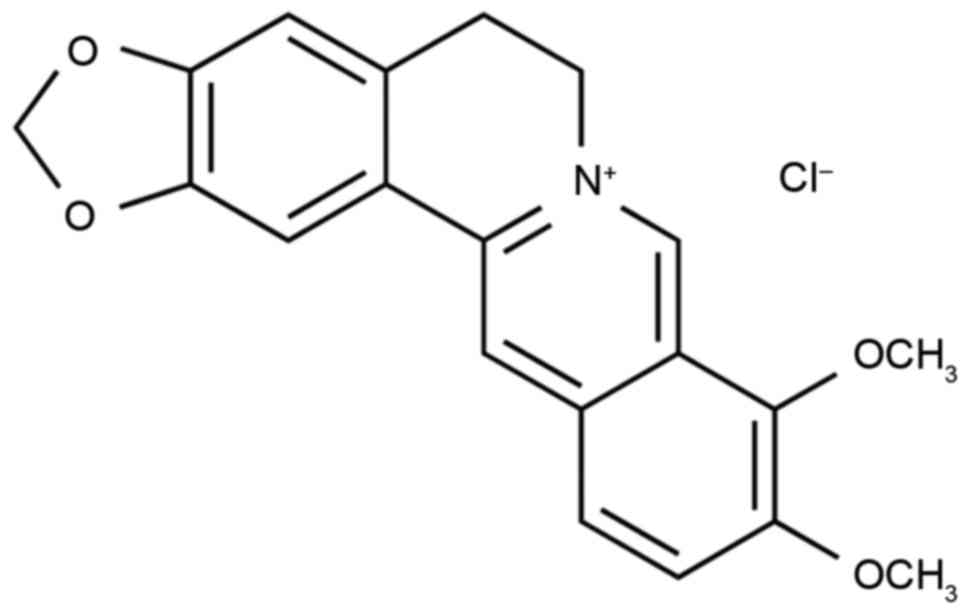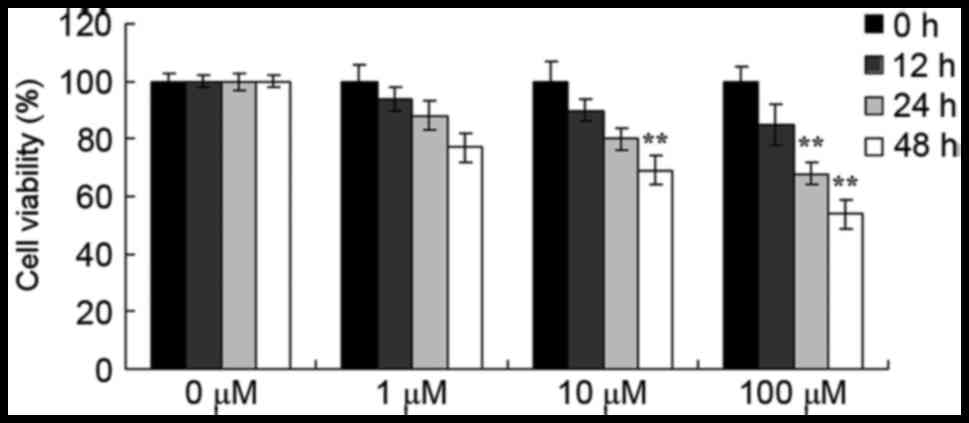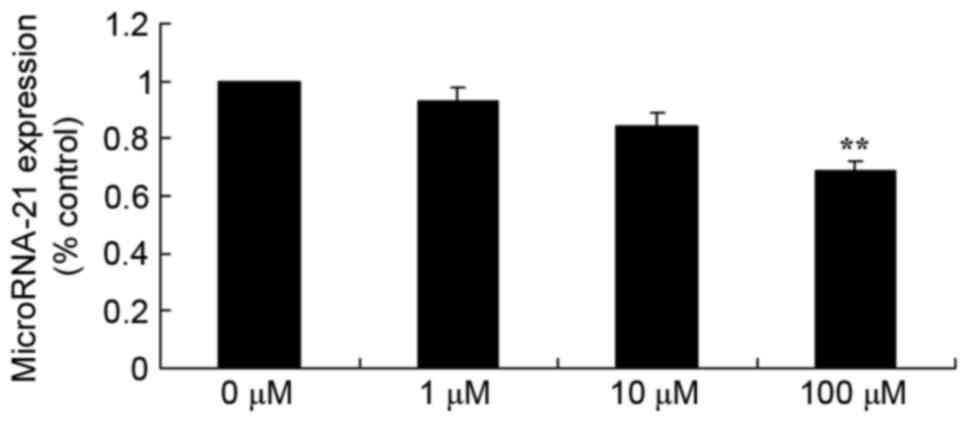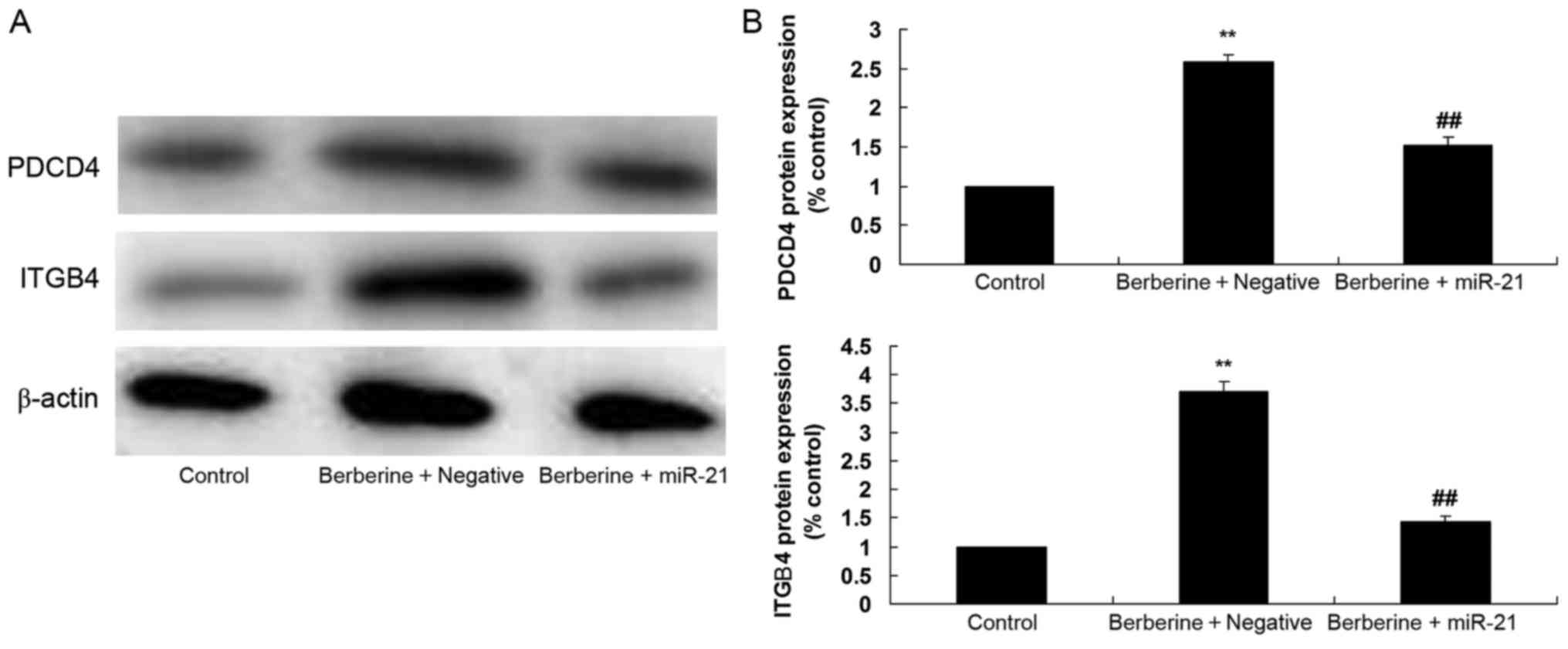Berberine regulates the microRNA‑21‑ITGΒ4‑PDCD4 axis and inhibits colon cancer viability
- Authors:
- Published online on: February 8, 2018 https://doi.org/10.3892/ol.2018.7997
- Pages: 5971-5976
Abstract
Introduction
Colon cancer is a type of malignant cancer with a high rate of incidence. Its morbidity is increasing and it is ranked third among malignant types of cancer in China, with an incidence rate of 12.81% in 2010 (1). At present, the morbidity of colon cancer is increasing due to the advancement of living standards and changes in dietary structure, including increased consumption of fatty components and decreased consumption of cellulose (2).
MicroRNA (miR/miRNA)-21 has previously been demonstrated to be upregulated in various types of tumors and to control the occurrence and progression of cancer (3). Tumors occur as a result of downregulation of cancer suppressor genes and overexpression of oncogenes (3). It has been demonstrated that miR-21 is a carcinogenic miRNA and it exhibits high expression levels in solid tumors, including head and neck neoplasms, esophageal, gastric, pancreatic, lung, liver, breast and prostatic cancer, and non-solid tumors including B cell lymphoma and chronic lymphocytic leukemia (4,5).
The occurrence of colon cancer is a complex process involving multiple genes and multiple steps (6). The mutation and deficiency of tumor suppressor genes is one of the important factors resulting in cell malignancy and metastasis (7). Multiple studies have endeavored to define the use of expression profiles in determining the occurrence and progression of colon cancer (7,8). In total, >200 miRNAs have been identified from 15 paired colon cancer and para-carcinoma tissues (9). Among the 132 miRNAs which are expressed in colorectal cancer (CRC) and para-carcinoma tissues, 47 of these have been revealed to be downregulated in colon cancer (10). A previous study has demonstrated that the upregulation of miR-21 is associated with CRC (10).
Studies on berberine (Fig. 1) have revealed that it is able to treat various infectious diseases, and that it is a potential anti-cancer treatment (11,12). Berberine is a Chinese herb extract with a long history. Clinically, it is used to treat gastrointestinal diseases including enteritis and bacillary dysentery. In previous years, berberine has been revealed to possess therapeutic actions against multiple types of cancer, including osteosarcoma, prostatic and liver cancer (13–15). The present study sought to define whether berberine inhibited cell viability and induced apoptosis of the HCT116 colon cancer cell line via the regulation of miR-21-integrin β4 (ITGβ4)-programmed cell death 4 (PDCD4).
Materials and methods
Cell lines and cell culture
The human CRC HCT116 cell line was purchased from Shanghai cell bank (Shanghai, China) maintained in Dulbecco's Modified Eagle's medium (Gibco; Thermo Fisher Scientific, Inc., Waltham, MA, USA) supplemented with 10% fetal bovine serum (Hyclone; GE Healthcare Life Sciences, Logan, UT, USA), 100 mg/ml streptomycin (Beyotime Institute of Biotechnology, Haimen, China) and 100 U/ml penicillin (Beyotime Institute of Biotechnology) at 37°C with 5% CO2 in a humidified atmosphere.
Cellular viability assay
Human CRC HCT116 cells (1×103 cell/well) were seeded into 96-well plates and cultivated with negative control (PBS), 1, 10 or 100 µM berberine for 48 h at 37°C. MTT was added to a final concentration of 0.5 mg/ml 48 h subsequent to berberine treatment and HCT116 cells were incubated for an additional 4 h at 37°C. DMSO was then added into each well and incubated for a further 20 min. The optical density was measured at 570 nm with a microplate spectrophotometer.
Apoptosis assay
HCT116 cells were plated in 6-well plates at a density of 5×105 cells/well and incubated with 1, 10 and 100 µM berberine for 24 h at 37°C. Flow cytometry (C6; BD Biosciences, Franklin Lakes, NJ, USA) was used to measure the apoptosis of HCT116 cells, 24 h following treatment with berberine. The relative amount of Annexin V-fluorescein isothiocyanate-positive-propidium iodide-negative cells were detected using an Apoptosis Detection kit I (BD Biosciences) and analyzed using Flowjo 7.6.1 (BD Biosciences).
Caspase-3 activity
HCT116 cells were plated in 6-well plates at a density of 5×105 cells/well and incubated with 1, 10 and 100 µM berberine for 24 h at 37°C. Proteins were extracted from HCT116 cells or HCT116 cells transfected by miR-21 using a protein extraction reagent (RIPA; Beyotime Institute of Biotechnology, Haimen, China). The supernatant was gathered after centrifugation at 12,000 × g for 10 min at 4°C and the protein concentration was measured using a BCA Protein Assay kit (Beyotime Institute of Biotechnology). An equal amount (50 µg) of total protein was incubated with Ac-IETD-pNA (Caspase-3 activity kit; cat. no. C1116; Beyotime Institute of Biotechnology) at 37°C for 4 h. Caspase-3 activity was detected using a microplate spectrophotometer, at a wavelength of 405 nm.
Reverse transcription-quantitative polymerase chain reaction (RT-qPCR)
HCT116 cells were plated in 6-well plates at a density of 5×105 cells/well and incubated with 1, 10 and 100 µM berberine for 24 h at 37°C. Total RNA was extracted from HCT116 cells cultured with berberine using TRIzol (Invitrogen; Thermo Fisher Scientific, Inc.), according to the manufacturer's protocol. RNA was then reverse transcribed into cDNA using a PrimeScript RT reagent kit (Takara Biotechnology Co., Ltd., Dalian, China). QPCR assay was performed on an Applied Biosystems ABI Prism 7000 sequence detection system using QuantiTect SYBR-Green PCR kit (Qiagen China Co., Ltd., Shanghai, China). The thermocycler conditions were as follows: 95°C for 5 min, followed by 35 cycles of 95°C for 30 sec, 58°C for 30 sec and 72°C for 30 sec. The primers used for stem-loop RT-qPCR for miR-21 and U6 are presented in Table I. The relative expression levels of the gene of interest were quantified using the 2−ΔΔCq method, and U6 represented the internal control (16).
Cell transfection
miR-21 mimics and negative control mimics sequences were as follows: 5′-UAGCUUAUCAGACUGAUGUUGA-3′ and 5′-CCCCCCCCCCCCCCCCCCCC-3′, respectively. miR-21 mimics and negative control mimics were transfected into HCT116 cells using Lipofectamine 2000 (Invitrogen; Thermo Fisher Scientific, Inc.) according to the manufacturer's protocol.
Western blot analysis
HCT116 cells were plated in 6-well plates (5×105 cells/well) and incubated with 1, 10 and 100 µM berberine for 24 h at 37°C. Proteins were extracted from HCT116 cells or HCT116 cells transfected with miR-21 using a protein extraction reagent (RIPA; Beyotime Institute of Biotechnology). The supernatant was gathered after centrifugation at 12,000 × g for 10 min at 4°C to measure protein concentration using a BCA Protein Assay kit (Beyotime Institute of Biotechnology). A total of 50 µg protein per lane from each sample was separated using 10–12% SDS-PAGE (Beyotime Institute of Biotechnology) and transferred onto a polyvinylidene difluoride membrane (Bio-Rad Laboratories, Inc., Hercules, CA, USA). The membrane was then blocked with 5% non-fat milk for 1 h at 37°C and incubated with ITGβ4 (dilution, 1:3,000; EPR8559; Abcam, Cambridge, UK), PDCD4 (dilution, 1:3,000; sc-376430; Santa Cruz Biotechnology, Inc.) and β-actin (dilution, 1:1,000; cat. no. sc-7210; Santa Cruz Biotechnology, Inc.) overnight at 4°C. The membranes were incubated with horseradish peroxidase-labeled goat anti-rabbit or anti-mouse immunoglobulin G (dilution, 1:1,000; sc-2004, sc-2005; Santa Cruz Biotechnology, Inc.) for 1 h at room temperature, and membranes were developed using an enhanced chemiluminescence kit according to the manufacturer's protocol (Beyotime Institute of Biotechnology) and quantified using sodium Image_Lab_3.0 (Bio-Rad Laboratories, Inc.).
Statistical analysis
All statistical analyses were performed using SPSS 12.0 software (SPSS, Inc., Chicago, IL, USA). Data are presented as the mean ± standard deviation. The differences between groups were analyzed using the Student's t-test. P<0.05 was considered to indicate a statistically significant difference.
Results
Berberine suppresses the viability of HCT116 cells
The results of the MTT assay demonstrated the anti-cancer effects of berberine on HCT116 cell viability. Berberine reduced the viability of HCT116 cells in a time- and dose-dependent manner (Fig. 2). Notably, treatment with 10 µM berberine significantly suppressed the cellular viability of HCT116 cells at 48 h, and treatment with 100 µM berberine also significantly suppressed the cellular viability of HCT116 cells at 24 or 48 h (Fig. 2).
Berberine induces apoptosis and caspase-3 activity of HCT116 cells
The results from flow cytometry analysis and the Business kit demonstrated that 100 µM berberine treatment significantly increased the apoptosis rate and promoted caspase-3 activity of HCT116 cells, (Fig. 3A and B, respectively), and the effect of berberine was dose-dependent.
Berberine suppresses miR-21 in HCT116 cells
In addition, the present study examined miR-21 expression in HCT116 cells treated with berberine using RT-qPCR. Compared with the 0 µM control group, miR-21 expression was significantly inhibited by treatment with 100 µM berberine (Fig. 4).
Berberine induces ITGβ4 protein expression in HCT116 cells
To explore the mechanisms underlying the effect of berberine on human colon cancer, ITGβ4 protein expression was detected using western blot analysis. ITGβ4 protein expression was significantly increased in HCT116 cells treated with 100 µM berberine compared with the 0 µM berberine group (Fig. 5).
Berberine induces PDCD4 protein expression in HCT116 cells
In order to detect the mechanisms by which berberine acts on human colon cancer, western blot analysis was used to analyze PDCD4 protein expression in HCT116 cell exposed to berberine. PDCD4 protein expression levels were significantly increased following treatment with 100 µM berberine compared with the 0 µM berberine group (Fig. 6).
Effect of miR-21 overexpression on the berberine-induced reduction of HCT116l cell viability
The present study analyzed the association between miR-21 and the anti-cancer effect of berberine on HCT116 cell viability. Transfection with miR-21 mimics significantly increased miR-21 expression levels in HCT116 cells (Fig. 7A) and that HCT116 cell viability was increased in cells treated with miR-21 mimics and 100 µM berberine compared with the group treated with 100 µM berberine only (Fig. 7B).
Effect of miR-21 overexpression on the effect of berberine on apoptosis and caspase-3 activity in HCT116 cells
To investigate the associations between miR-21 and the anti-cancer effects of berberine on apoptosis in HCT116 cells and HCT116 cells transfected with miR-21, the apoptosis rate and caspase-3 activity of HCT116 cells were measured using flow cytometry and caspase-3 activity kit, respectively. The rate of apoptosis and caspase-3 activity were significantly decreased in HCT116 cells treated with 100 µM berberine and miR-21 mimics, compared with the group treated with 100 µM berberine alone (Fig. 8A and B, respectively).
Effect of miR-21 overexpression on the effect of berberine on ITGβ4 and PDCD4 protein expression levels in HCT116 cells
To investigate the association between miR-21 and the anti-cancer effects of berberine on ITGβ4 and PDCD4 protein expression in HCT116 cells, western blot analysis was performed. Overexpression of miR-21 significantly suppressed the 100 µM berberine-induced increase of ITGβ4 and PDCD4 protein expression levels in HCT116 cells, compared with the group treated with 100 µM berberine alone (Fig. 9).
Discussion
The morbidity rate of colon cancer is high and is increasing annually, with a clear increase being observed in developed countries and developing countries (17). Among malignant tumors of the digestive tract, colon cancer ranks the fourth in terms of mortality rates in China (17). The occurrence and progression of colon cancer involves multiple-genes (18). The present study revealed that berberine significantly suppressed cell viability, induced apoptosis and increased caspase-3 activity in human colon cancer HCT116 cells. Previous studies have demonstrated that berberine inhibits cell proliferation, induces apoptosis and inhibits the invasion of human skin squamous cell carcinoma A431 cells (19), human ovarian cancer cells (20) and CRC cells (21).
miRNAs are non-coding molecules which are expressed in breast, lung, gastric, prostate, liver, colon and pancreatic cancer, spongioblastoma, pancreatic neuroendocrine tumor and cancer of the biliary duct (22). Since miRNAs frequently occur on complementary fragments, it is assumed that miRNAs have a relatively close association with the occurrence and progression of various types of cancer (8). It has previously been demonstrated that miR-21 has clinical and practical values for the diagnosis, treatment, assessment and prognosis of cancers (23).
miR-21 is involved in the processes of cell proliferation, invasion, blood vessel invasion and metastasis of multiple types of cancer (24). It has been demonstrated that miR-21 is associated with the sensitivity of anti-cancer drugs in vitro (24). Multiple signal pathways and regulatory factors are involved in influencing the sensitivity of anti-cancer drugs (25). Thus, miR-21 is deemed to be a potential therapeutic target. Antisense oligodeoxynucleotides combine with mature and carcinogenic miRNAs to inhibit tumor growth (26). miR-21 inhibitors increase the sensitivity of tumor cells to chemotherapeutic agents (25). Following treatment with berberine, miR-21 expression was significantly inhibited in human colon cancer HCT116 cells. In addition, overexpression of miR-21 significantly inhibited the anti-cancer effect of berberine on viability, apoptosis and caspase-3 activity in HCT116 cells. Hu et al (27) previously reported that berberine inhibited NF-κB and lead to a decrease in the levels of miR-21 and B cell lymphoma 2.
Integrin is a heterodimer molecule formed from two subunits, α and β (28). In total, 20 α and β types have been identified, which combine into various forms. The subunits of α and β are comprised of an extracellular region and a transmembrane domain, and the intracellular region ITGβ4 determines the specificity to physiological and pathological processes, including the inflammatory response, the immune response, proliferation, differentiation, vascularization, fertilization, embryo implantation and growth (29). The present study observed that berberine induced ITGβ4 protein expression in HCT116 cells.
There have been few previous studies investigating miR-21 in colon cancer. Studies have identified that increased expression of miR-21 downregulated expression levels of PDCD4, which is a cancer suppressor gene (5,9). PDCD4 and miR-21 have been demonstrated to be associated with gastric carcinoma, colon and breast cancer (30). The results of the present study demonstrated that berberine induced PDCD4 protein expression in HCT116 cells. Overexpression of miR-21 was observed to significantly inhibit the anti-cancer effect of berberine on ITGβ4/PDCD4 protein expression levels in HCT116 cells.
In conclusion, the present data provided evidence that berberine significantly suppressed cell viability, induced apoptosis and increased caspase-3 activity in human colon cancer HCT116 cells. The present study also demonstrated an association between miR-21 and the anti-cancer effect of berberine on the viability of colon cancer cells, which may be regulated by the miR-21-ITGβ4-PDCD4 signaling pathway. This is supported by the results of Liu et al (31), who also previously suggested that berberine sensitizes cisplatin-induced ovarian cancer cells through the miR-21/PDCD4 axis. The present study may contribute to the development of berberine for the treatment and prevention of human colon cancer.
Acknowledgements
The present study was supported by the Natural Sciences Foundation of Shandong (grant no. ZR2011HQ049) and the Jinan Youth Science and Technology Star Plan (grant nos. 20100405 and 20090208).
References
|
Holt PR, Kozuch P and Mewar S: Colon cancer and the elderly: From screening to treatment in management of GI disease in the elderly. Best Pract Res Clin Gastroenterol. 23:889–907. 2009. View Article : Google Scholar : PubMed/NCBI | |
|
Radhakrishnan EK, Bava SV, Narayanan SS, Nath LR, Thulasidasan AK, Soniya EV and Anto RJ: [6]-Gingerol induces caspase-dependent apoptosis and prevents PMA-induced proliferation in colon cancer cells by inhibiting MAPK/AP-1 signaling. PLoS One. 9:e1044012014. View Article : Google Scholar : PubMed/NCBI | |
|
Zhu W and Xu B: MicroRNA-21 identified as predictor of cancer outcome: A meta-analysis. PLoS One. 9:e1033732014. View Article : Google Scholar : PubMed/NCBI | |
|
Ribas J and Lupold SE: The transcriptional regulation of miR-21, its multiple transcripts, and their implication in prostate cancer. Cell Cycle. 9:923–929. 2010. View Article : Google Scholar : PubMed/NCBI | |
|
Young MR, Santhanam AN, Yoshikawa N and Colburn NH: Have tumor suppressor PDCD4 and its counteragent oncogenic miR-21 gone rogue? Mol Interv. 10:76–79. 2010. View Article : Google Scholar : PubMed/NCBI | |
|
Wang J, Du Y, Liu X, Cho WC and Yang Y: MicroRNAs as regulator of signaling networks in metastatic colon cancer. Biomed Res Int. 2015:8236202015.PubMed/NCBI | |
|
Hollis M, Nair K, Vyas A, Chaturvedi LS, Gambhir S and Vyas D: MicroRNAs potential utility in colon cancer: Early detection, prognosis, and chemosensitivity. World J Gastroenterol. 21:8284–8292. 2015. View Article : Google Scholar : PubMed/NCBI | |
|
Melo SA and Esteller M: Dysregulation of microRNAs in cancer: Playing with fire. FEBS Lett. 585:2087–2099. 2011. View Article : Google Scholar : PubMed/NCBI | |
|
Qiu X, Dong S, Qiao F, Lu S, Song Y, Lao Y, Li Y, Zeng T, Hu J, Zhang L, et al: HBx-mediated miR-21 upregulation represses tumor-suppressor function of PDCD4 in hepatocellular carcinoma. Oncogene. 32:3296–3305. 2013. View Article : Google Scholar : PubMed/NCBI | |
|
Mercado-Pimentel ME, Onyeagucha BC, Li Q, Pimentel AC, Jandova J and Nelson MA: The S100P/RAGE signaling pathway regulates expression of microRNA-21 in colon cancer cells. FEBS Lett. 589:2388–2393. 2015. View Article : Google Scholar : PubMed/NCBI | |
|
Shi G, Shao J, Wang T, Wu D and Wang C: Mechanism of berberine-mediated fluconazole-susceptibility enhancement in clinical fluconazole-resistant Candida tropicalis isolates. Biomed Pharmacother. 93:709–712. 2017. View Article : Google Scholar : PubMed/NCBI | |
|
Daniel B, Konrad B, Toplak M, Lahham M, Messenlehner J, Winkler A and Macheroux P: The family of berberine bridge enzyme-like enzymes: A treasure-trove of oxidative reactions. Arch Biochem Biophys. 632:88–103. 2017. View Article : Google Scholar : PubMed/NCBI | |
|
Li M, Zhang M, Zhang ZL, Liu N, Han XY, Liu QC, Deng WJ and Liao CX: Induction of apoptosis by berberine in hepatocellular carcinoma HepG2 cells via downregulation of NF-κB. Oncol Res. 25:233–239. 2017. View Article : Google Scholar : PubMed/NCBI | |
|
Li X, Zhang A, Sun H, Liu Z, Zhang T, Qiu S, Liu L and Wang X: Metabolic characterization and pathway analysis of berberine protects against prostate cancer. Oncotarget. 8:65022–65041. 2017.PubMed/NCBI | |
|
Zhu Y, Ma N, Li HX, Tian L, Ba YF and Hao B: Berberine induces apoptosis and DNA damage in MG63 human osteosarcoma cells. Mol Med Rep. 10:1734–1738. 2014. View Article : Google Scholar : PubMed/NCBI | |
|
Livak KJ and Schmittgen TD: Analysis of relative gene expression data using real-time quantitative PCR and the 2(-Delta Delta C(T)) method. Methods. 25:402–408. 2001. View Article : Google Scholar : PubMed/NCBI | |
|
He SY, Jiang RF, Jiang J, Xiang YS and Wang L: Investigation of methylation and protein expression of the Runx3 gene in colon carcinogenesis. Biomed Rep. 3:687–690. 2015. View Article : Google Scholar : PubMed/NCBI | |
|
Lee LD, Mafura B, Lauscher JC, Seeliger H, Kreis ME and Gröne J: Antiproliferative and apoptotic effects of telmisartan in human colon cancer cells. Oncol Lett. 8:2681–2686. 2014. View Article : Google Scholar : PubMed/NCBI | |
|
Li DX, Zhang J, Zhang Y, Zhao PW and Yang LM: Inhibitory effect of berberine on human skin squamous cell carcinoma A431 cells. Genet Mol Res. 14:10553–10568. 2015. View Article : Google Scholar : PubMed/NCBI | |
|
Chen Q, Qin R, Fang Y and Li H: Berberine sensitizes human ovarian cancer cells to cisplatin through miR-93/PTEN/Akt signaling pathway. Cell Physiol Biochem. 36:956–965. 2015. View Article : Google Scholar : PubMed/NCBI | |
|
Liu X, Ji Q, Ye N, Sui H, Zhou L, Zhu H, Fan Z, Cai J and Li Q: Berberine inhibits invasion and metastasis of colorectal cancer cells via COX-2/PGE2 mediated JAK2/STAT3 signaling pathway. PLoS One. 10:e01234782015. View Article : Google Scholar : PubMed/NCBI | |
|
Reid G: MicroRNAs in mesothelioma: From tumour suppressors and biomarkers to therapeutic targets. J Thorac Dis. 7:1031–1040. 2015.PubMed/NCBI | |
|
Pink RC, Samuel P, Massa D, Caley DP, Brooks SA and Carter DR: The passenger strand, miR-21-3p, plays a role in mediating cisplatin resistance in ovarian cancer cells. Gynecol Oncol. 137:143–151. 2015. View Article : Google Scholar : PubMed/NCBI | |
|
Wang W, Li J, Zhu W, Gao C, Jiang R, Li W, Hu Q and Zhang B: MicroRNA-21 and the clinical outcomes of various carcinomas: A systematic review and meta-analysis. BMC Cancer. 14:8192014. View Article : Google Scholar : PubMed/NCBI | |
|
Xu G, Zhang Y, Wei J, Jia W, Ge Z, Zhang Z and Liu X: MicroRNA-21 promotes hepatocellular carcinoma HepG2 cell proliferation through repression of mitogen-activated protein kinase-kinase 3. BMC Cancer. 13:4692013. View Article : Google Scholar : PubMed/NCBI | |
|
He C, Dong X, Zhai B, Jiang X, Dong D, Li B, Jiang H, Xu S and Sun X: MiR-21 mediates sorafenib resistance of hepatocellular carcinoma cells by inhibiting autophagy via the PTEN/Akt pathway. Oncotarget. 6:28867–28881. 2015. View Article : Google Scholar : PubMed/NCBI | |
|
Hu HY, Li KP, Wang XJ, Liu Y, Lu ZG, Dong RH, Guo HB and Zhang MX: Set9, NF-κB, and microRNA-21 mediate berberine-induced apoptosis of human multiple myeloma cells. Acta Pharmacol Sin. 34:157–166. 2013. View Article : Google Scholar : PubMed/NCBI | |
|
Lo AK, Yuen PW, Liu Y, Wang XH, Cheung AL, Wong YC and Tsao SW: Downregulation of hemidesmosomal proteins in nasopharyngeal carcinoma cells. Cancer Lett. 163:117–123. 2001. View Article : Google Scholar : PubMed/NCBI | |
|
Ferraro A, Kontos CK, Boni T, Bantounas I, Siakouli D, Kosmidou V, Vlassi M, Spyridakis Y, Tsipras I, Zografos G and Pintzas A: Epigenetic regulation of miR-21 in colorectal cancer: ITGβ4 as a novel miR-21 target and a three-gene network (miR-21-ITGβ4-PDCD4) as predictor of metastatic tumor potential. Epigenetics. 9:129–141. 2014. View Article : Google Scholar : PubMed/NCBI | |
|
Wang Y, Gao X, Wei F, Zhang X, Yu J, Zhao H, Sun Q, Yan F, Yan C, Li H and Ren X: Diagnostic and prognostic value of circulating miR-21 for cancer: A systematic review and meta-analysis. Gene. 533:389–397. 2014. View Article : Google Scholar : PubMed/NCBI | |
|
Liu S, Fang Y, Shen H, Xu W and Li H: Berberine sensitizes ovarian cancer cells to cisplatin through miR-21/PDCD4 axis. Acta Biochim Biophys Sin (Shanghai). 45:756–762. 2013. View Article : Google Scholar : PubMed/NCBI |


















